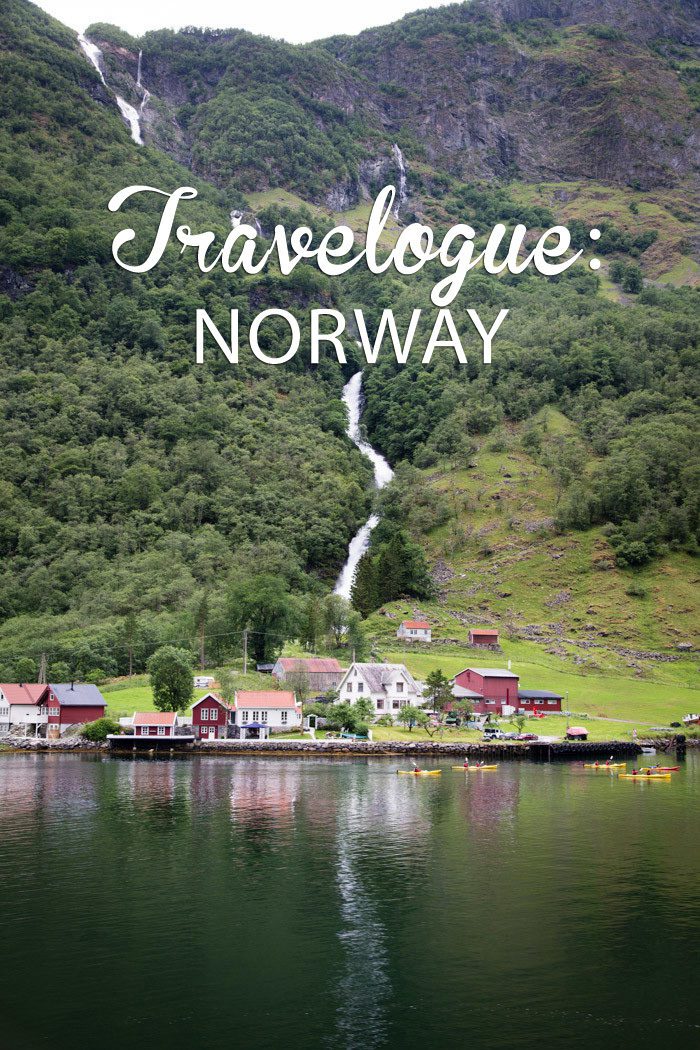
We were only in Norway for three days, but it made a big impression! We certainly went back and forth a few times about whether it was crazy of us to fly there for such a brief stay, but it’s not the easiest place to get to from California, and I’ve always wanted to ferry down a fjord. It was going to happen!
The classic tourist circuit in Norway is something called “Norway in a Nutshell,” with which you get a taste of that dramatic scenery while connecting the two cities of Bergen—on the coast—and Oslo. As soon as I heard the moniker, my gut said “no way!” Too pat. But after posting hesitant queries to forums and in the comments of this post, the most prescient consensus was that it’s one of those routes that’s popular for a reason, and that while the more off-the-beaten path one you might come up with will be amazing, it will take longer, and involve a lot more travel time in cars or on boats. I thought about more time of asking the kids to try and sit still whilst appreciating grand, sweeping views and thought “Nutshell it is!”

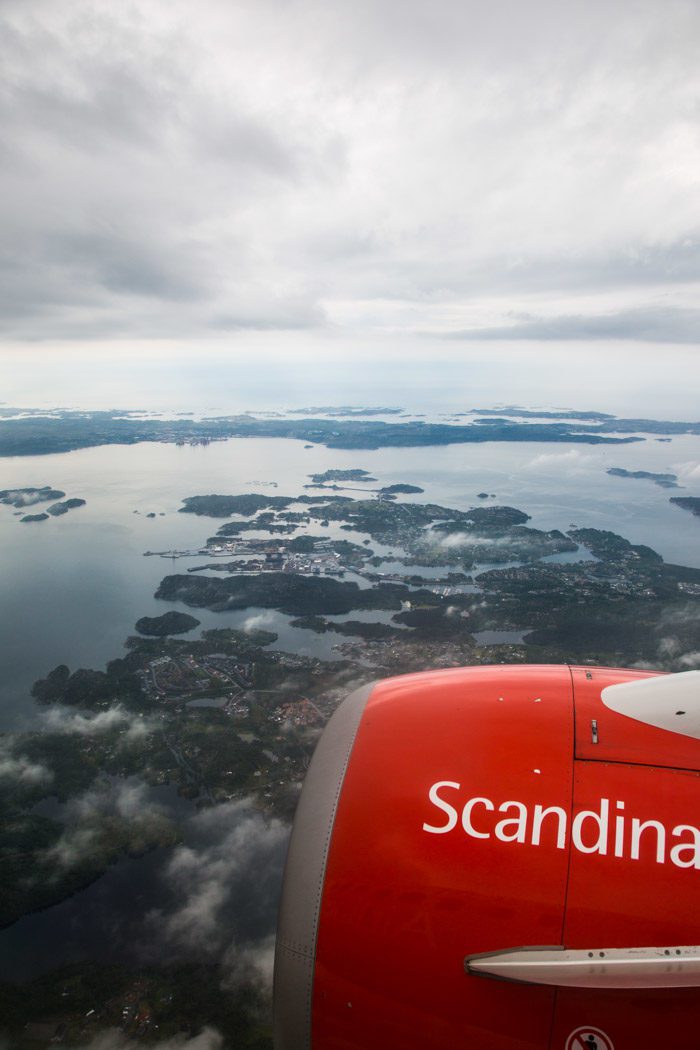
The most common route is to fly into Oslo and end the trip in Bergen, but we couldn’t see any reason why it wouldn’t work just as well to go in the reverse. There’s a joke in the Rick Steves’s guide that you just have to flip the book upside down. It did sort of feel that way, the route is so well established in one direction.
But we did a somersault and landed in Bergen.
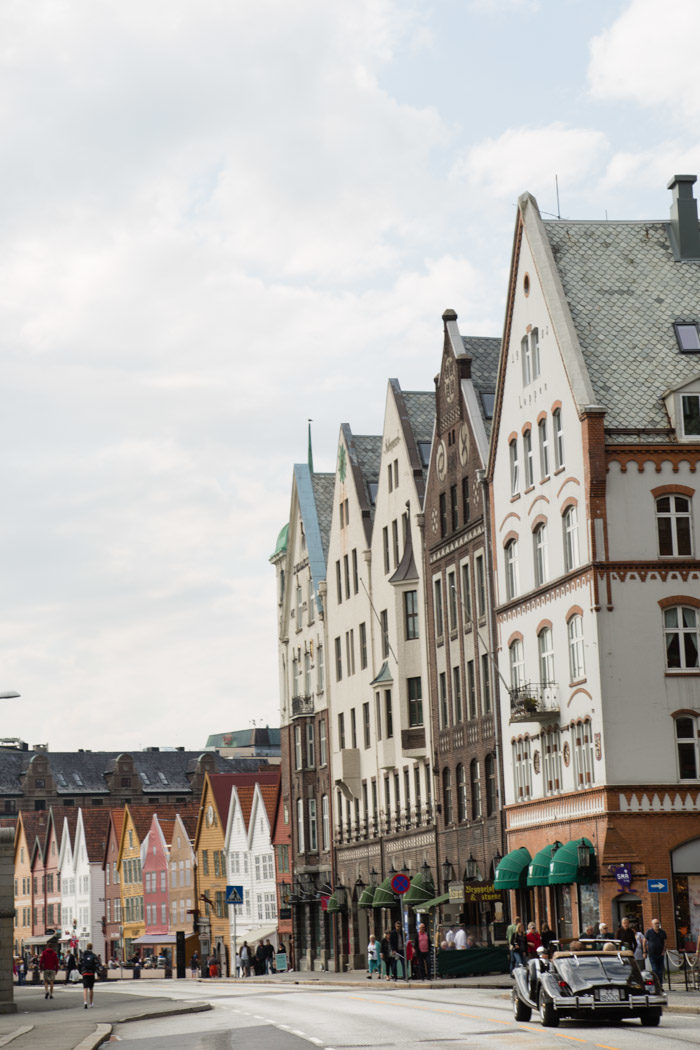
Before we arrived in Bergen, I’d read that it rains all the time—it’s Norway’s rainiest city. Apparently, in 2006 it once rained for 85 days straight! We’d been checking the forecast, crossing our fingers for a clear day on the Fjord, but fully expected that we’d get some soggy weather.
So when we flew in on Midsommer’s Eve to a clear, sunny sky, I knew we’d gotten incredibly lucky and should try to take full advantage. No dilly-dallying!
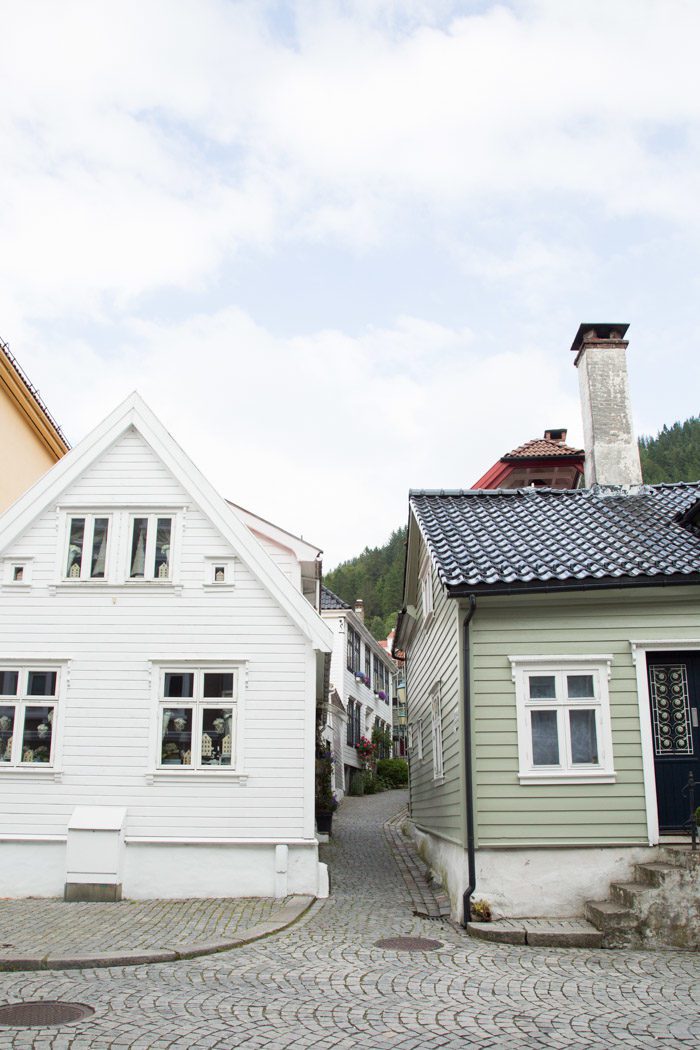
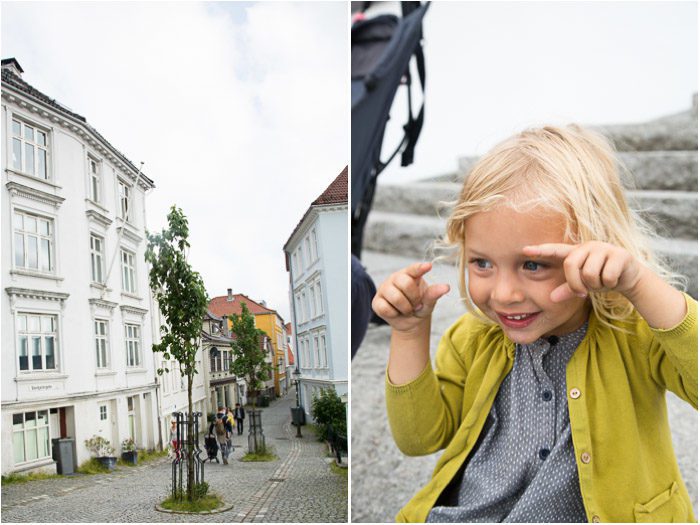
On the taxi ride from the airport to our apartment rental, through a series of very long tunnels, the driver gave us a general overview of the employment and education system in Norway as well as his (and his midwestern cousins’) impressions of the American election. Luckily, we were all on the same page.
By the time I thought to ask about Christmas traditions, à la David Sedaris, we’d pulled up to our little white house in North Bergen, near a park and a school and—phew!—a playground.
We were lucky to get a spot at all, having reserved one of the last AirBnBs in town a few days earlier. Did I mention we waffled a lot on our exact itinerary? It turned out that Sir Paul McCartney was playing the new arena the next night, and everything was fully booked.
I wasn’t too worried: we don’t typically spend too much time inside, but this was an especially unfortunate setup: Our two bedrooms weren’t actually in the same place! One bed with a desk and a poster reading “Mo’ money mo’ problems” sat across the hall from another room with a kitchenette, bedroom, and bathroom. We couldn’t leave our kids alone in either so, lucky for me, Aron volunteered to take the couch, and I got a little mini-vacay in the locked room across the hall. The kids took the other bedroom.
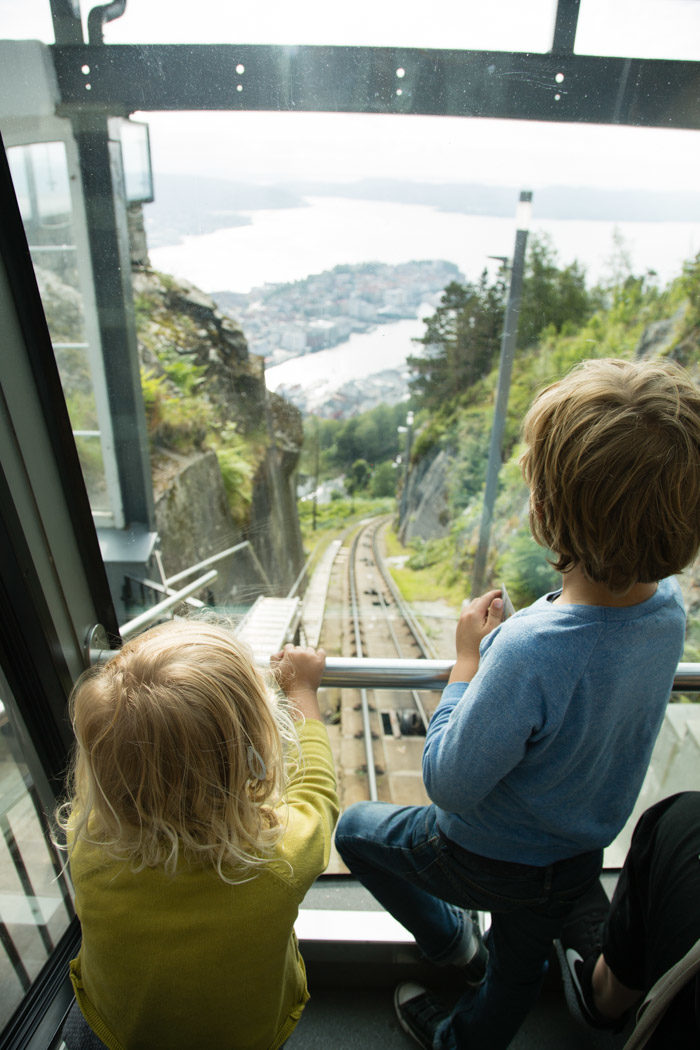
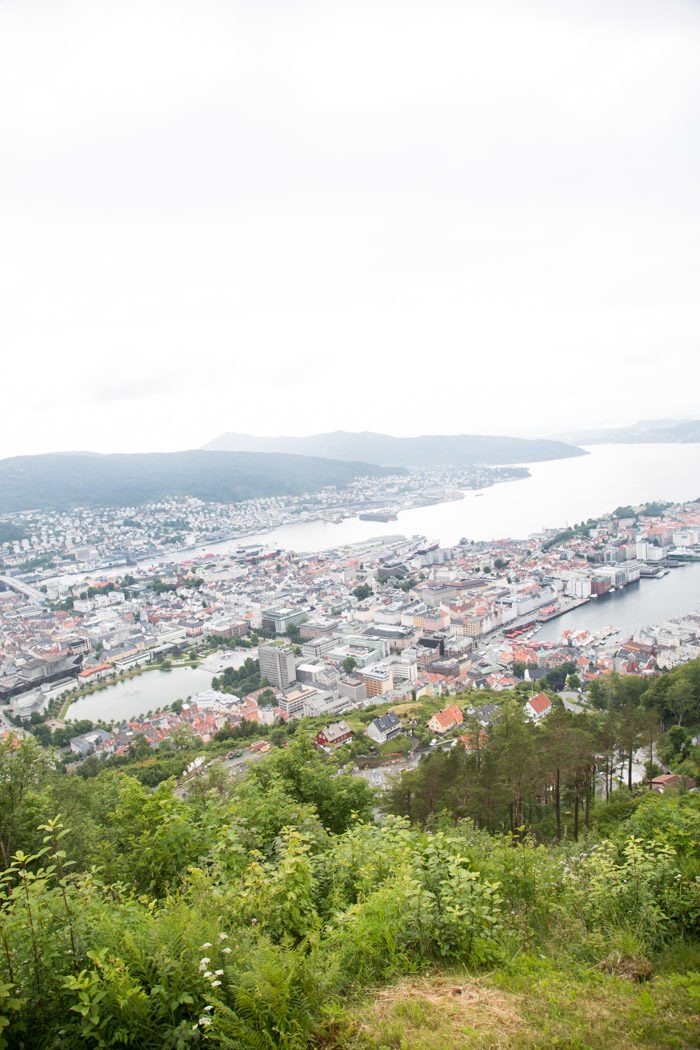
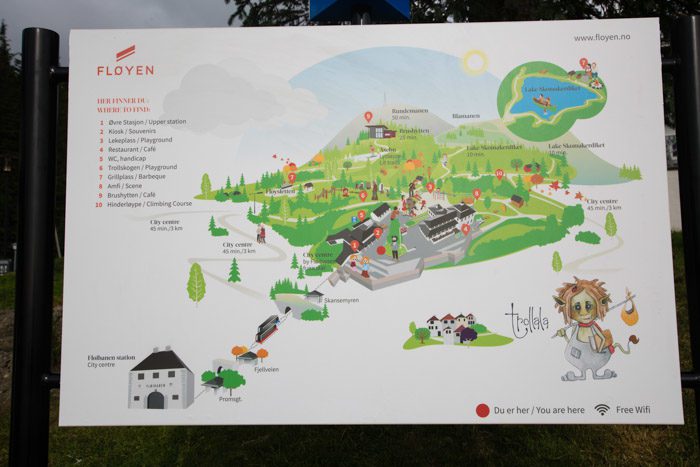
One of the top things to do in town is to take the Fløibanen Funicular up Fløyen Mountain for panoramic views and hiking trails. With the sun out, it was the perfect thing to do. We bought tickets at the little cafe down the street from the entrance where you can get a combo ticket with coffee and pastries.
From the top, you can better appreciate Bergen’s size: over 250,000 people call it home. Beyond its historic quarters is a modern city, second only to Oslo in size.

There’s a great playground at top (of course!), making it a favorite stop for everyone.


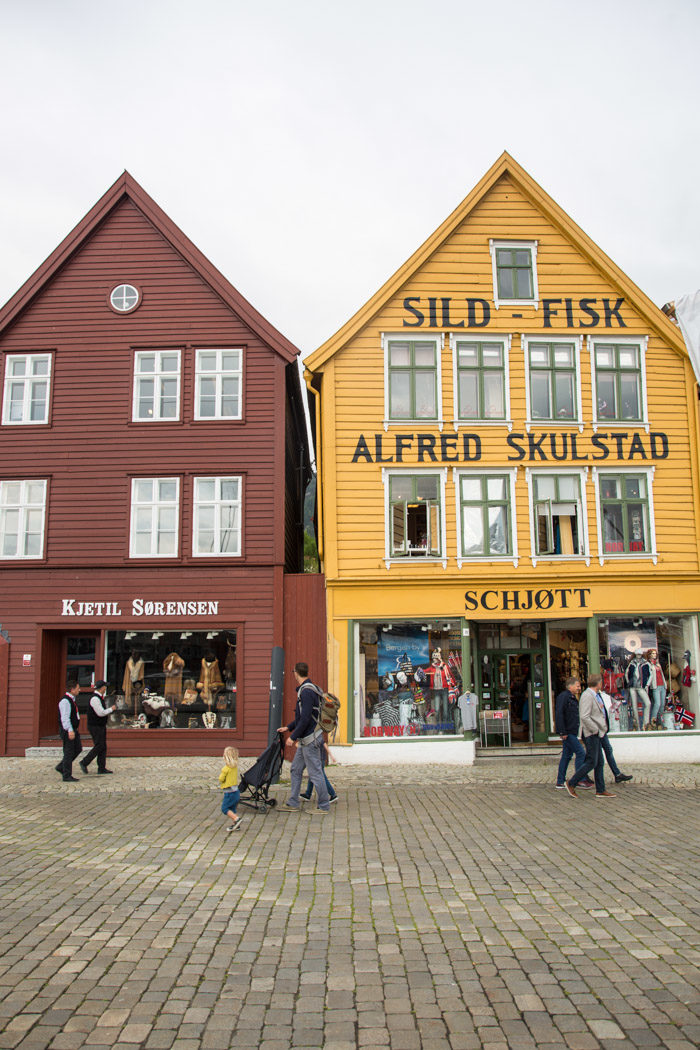
Once a member of the Hanseatic League and a major trading center on the route from London to Russia, Bergen is probably best known for it’s old wharf—the Bryggen—a historic quarter on the Unesco World Heritage list with 62 colorful wooden buildings dating to the 1300s that was mostly run by German merchants.
Long, leaning rows of buildings have burned down and been rebuilt several times, and even though it’s full of tourist shops and galleries, it’s a pleasure to stroll through. In fact, one of my favorite parts was peeking into the conservation and reconstruction efforts. Built with a rough-plank construction that’s prone to rot, they are doing some rebuilding that will take years to finish as they painstakingly restrict themselves to old patterns, materials, and methods. You can see archaeological excavations taking place, part of a project started in 2000.
The area is apparently subject of a daily cruise ship and bus tour crush, but it grows quiet after 4pm.
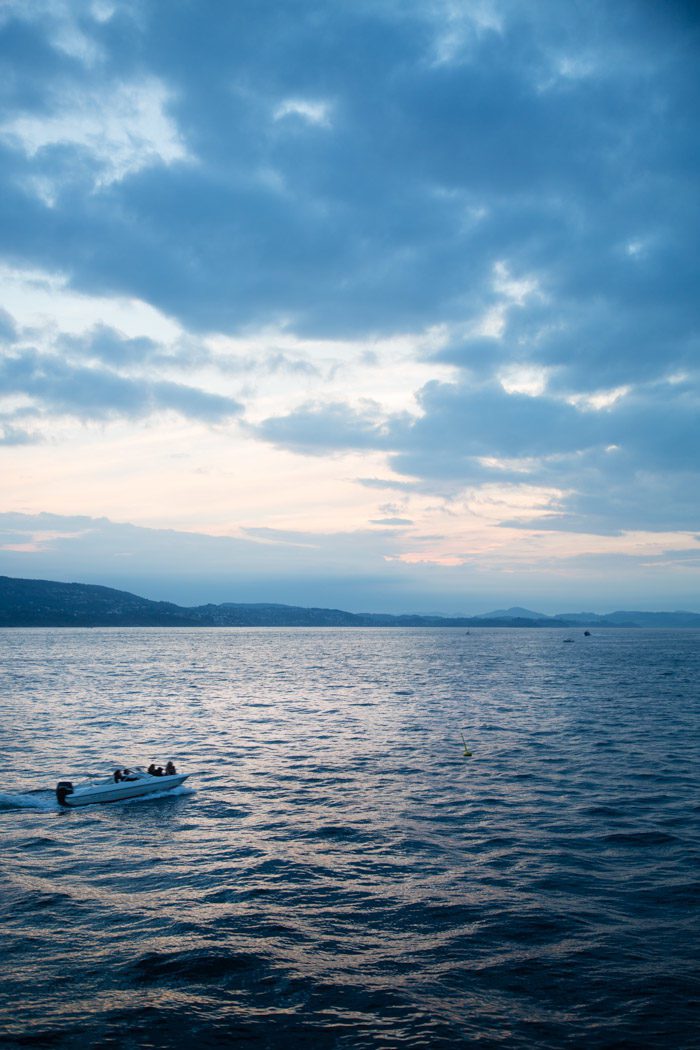
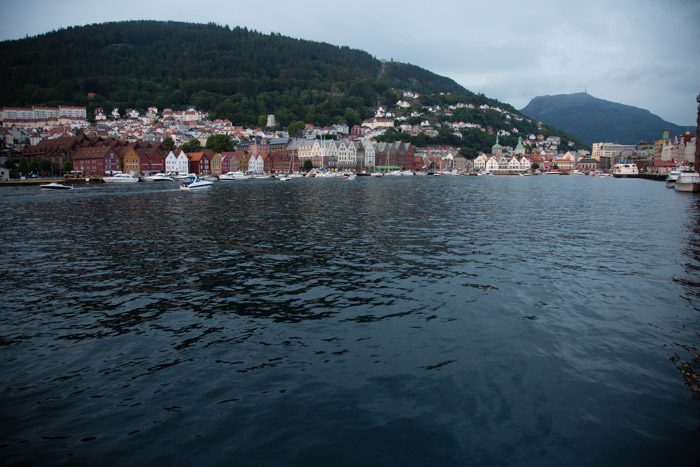

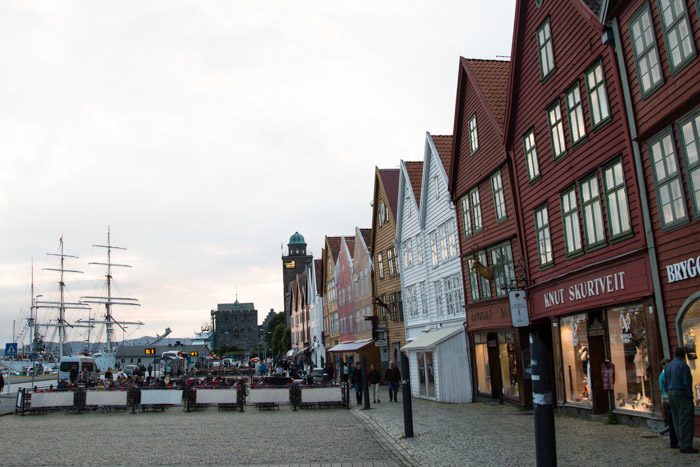
We stayed out late and then stopped by a seven-eleven for some provisions (bin candy and a sort of air-whipped nutella-like spread proved very tempting). And then, after the kids were asleep, Aron went back out to take some photos of the city and look for midsummer celebration bonfires. (There was a giant one!) The sun set around 11:15pm that night.

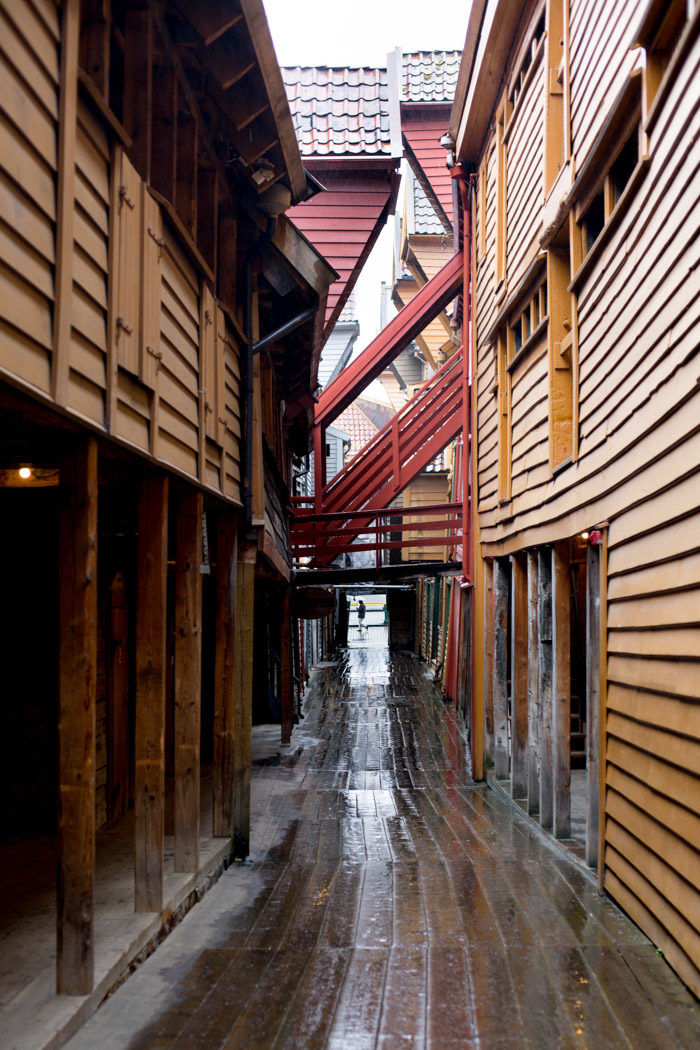


The next morning, everyone sort of woke up in a funk—the kids and the city, it seemed.
I actually have a theory that a week is the sweet spot for vacations with kids this age (when you’re trying to push through the jet lag, especially), but who wants to go all the way across an ocean and turn around after a week? It’s not that two or three weeks can’t also be good—and maybe those who have longer just sleep the first few days and it all evens out—but I find that everyone in our family is so excited about the new place and the new adventures that the creeping sleep deprivation can be ignored. And then, a week in, comes the crash. Suddenly the lack of routine feels a bit more acute, the adventures a bit less fresh, and everyone gets a little cranky.
One gets over it, obviously, but on this day I think we all felt a bit tired… and wet! It rained all day.
We’d made our way to the Bryggen for a tour and when even the giant cod didn’t prove interesting enough to engender any cooperation from the kids, Aron turned back for an early nap. (Again, history takes a back seat at this stage.) This UNESCO description is a nice overview, but I wish we could say we spent more time learning about the city’s history first-hand.
I stayed out to do a little shopping in the old quarter. Some highlights:
Røst was a favorite find: right in the centre of Bryggen with lots of Norwegian and Scandinavian objects and homewares, as some fashion. Aksdal i Muren is a wonderful stop for classic Norwegian (read: expert) rain gear. Sadly, it was closed when I passed by. But my favorite of all along the Bryggen was Ting and its children’s shop, Småting. I made sure we returned with the kids later (they even had a little play space in the corner to entertain little ones while you shop).
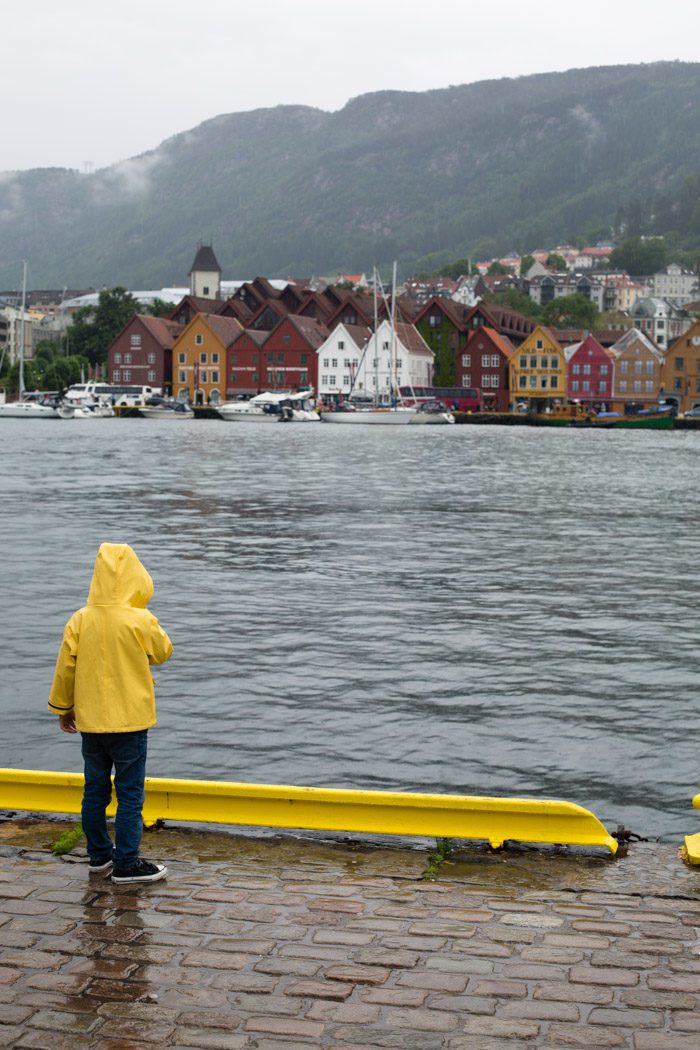

When I came back, we all put on fresh socks and rallied for a second go…
A fish market dominates the central waterfront square. And though it’s no longer really used by locals, the the tented stalls offer a glimpse into Norway’s history. Cod—dried, preseved, fresh, in the form of caviar—was once the city’s main trade, and you can find everything from salmon to whale (which we of course declined). Today, you can have a meal of delicious seafood just behind the stalls.
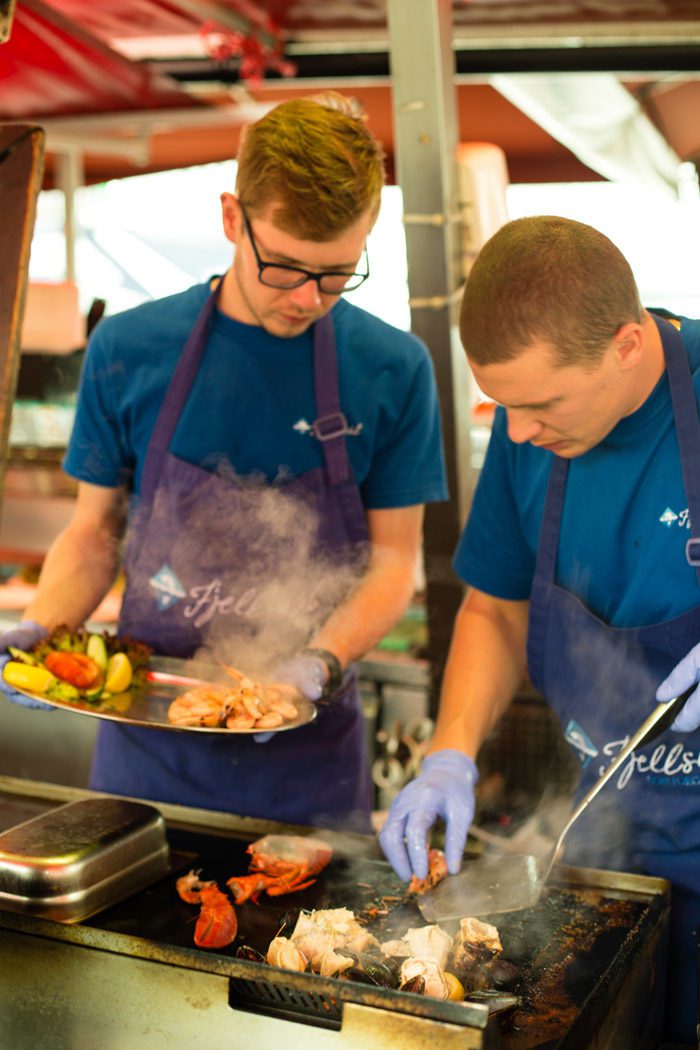
This company, Fjellskal, has a large presence—both in the tented stalls and inside a new food market hall on the other side of the wharf. A meal of steamed mussels would set you back 129 Kr, while a large shellfish mixplate cost 699 Kr (about $15-85 US, currently), so it’s comparable to a restaurant in price.

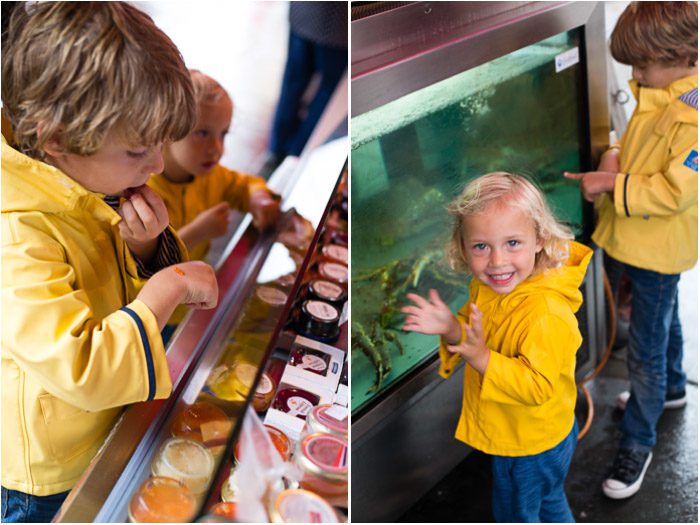
But you can do pretty well sampling and picking up fresh lox. Hudson loved the caviar, to our surprise. Reindeer jerky was also something he enjoyed.
(Skyler is clapping because, with her cheering, one of the giant King crabs finally flipped itself over.)
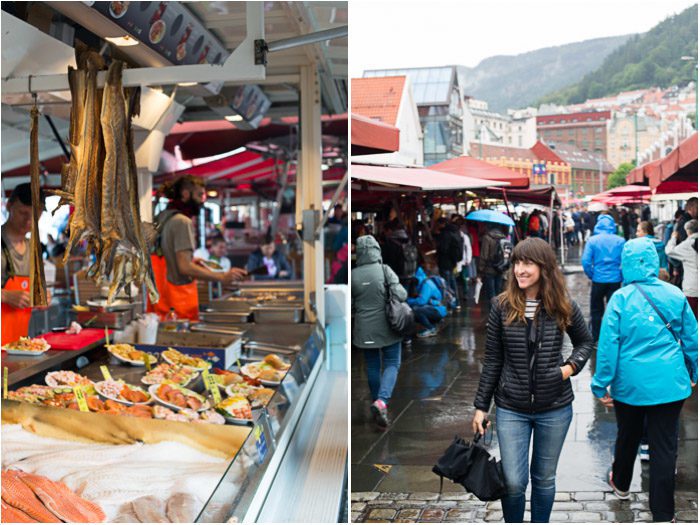
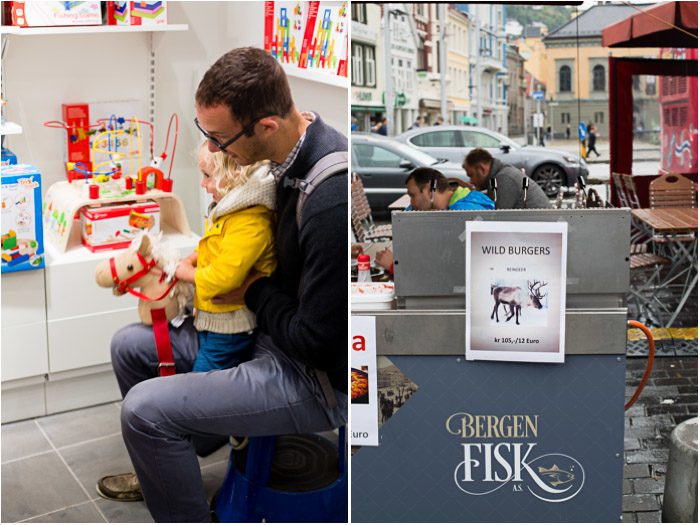
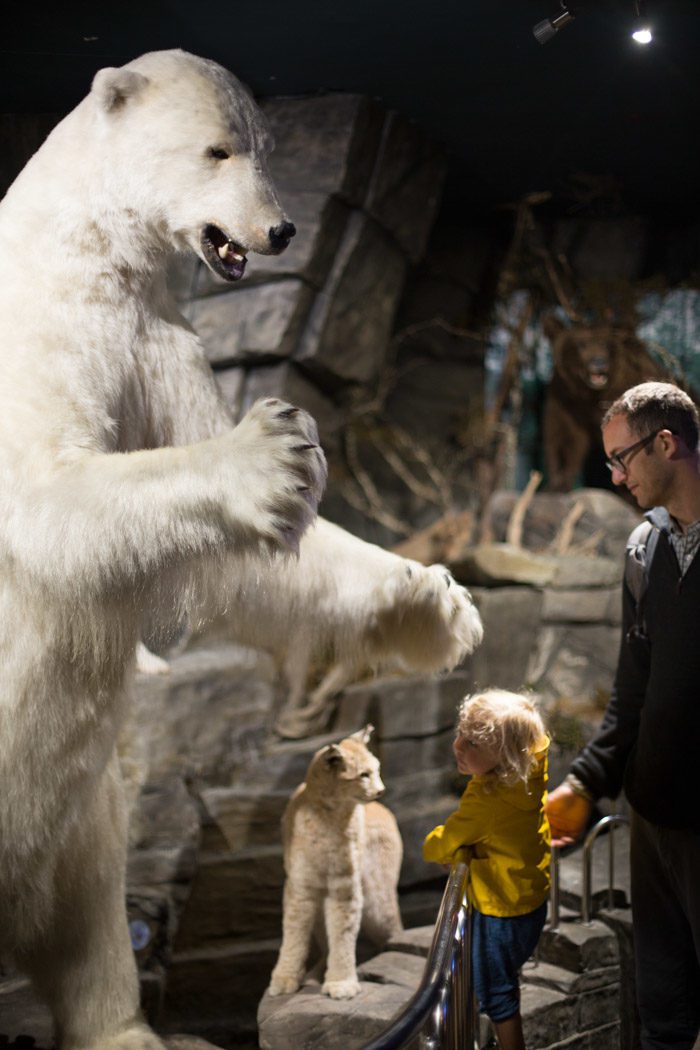
But eventually we decided to focus on something we knew the kids would really love: the aquarium.
It’s kind of a funny mix of creatures (there were a lot of crocodiles and tropical terrariums) so I wouldn’t say it makes a great region-specific attraction, but we had a nice time: our favorite features were the touch pools with local crabs (so much colder), a display of taxidermy featuring native mammals (that polar bear! So close!), a few tanks of fish and a movie about the orcas you’d find in the waters just outside, and the penguins (who were right there in the open air—something of a rare sight for a Californian)!
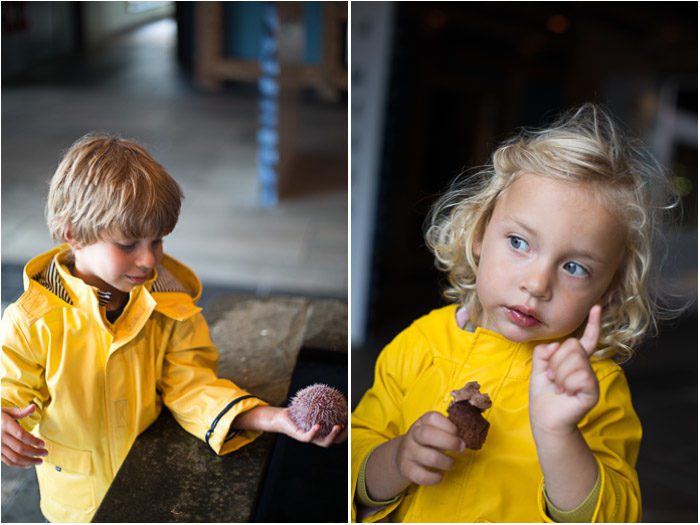
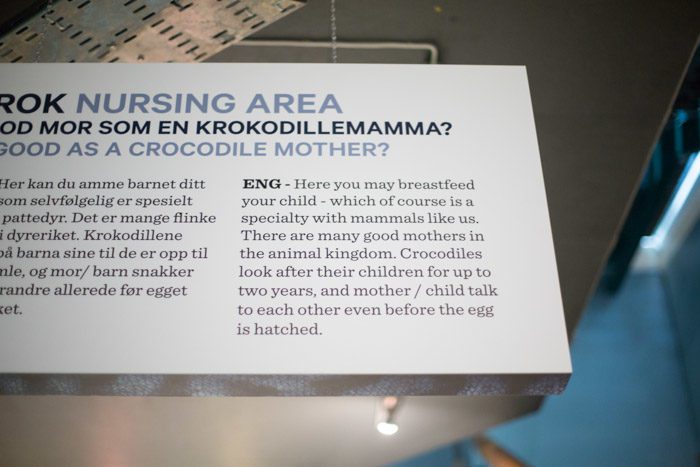
Some of the signs were also interesting for their cultural specificity. This one, for a nursing area, and one about how local children bring their pacifiers for the Koi fish as a way to give them up, were favorites of mine.
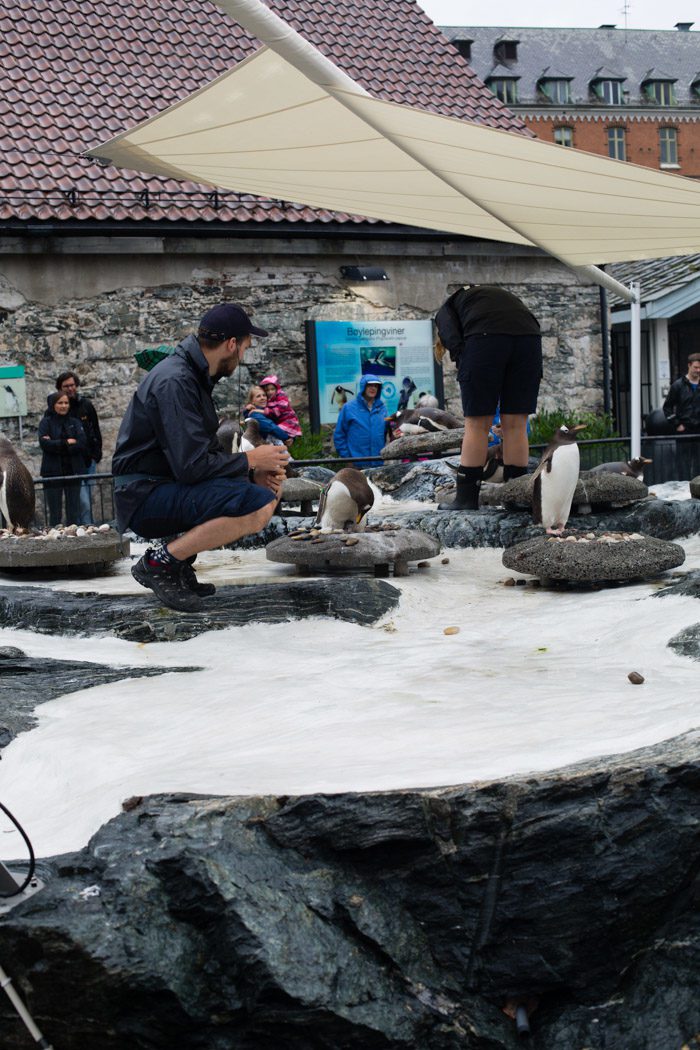
The penguins were roosting and this one was feeding his or her one-day old hatchling! Incredible!
We had dinner along the Bryggen that evening at Bryggeloftet & Stuene, which a man in the historical office had suggested as the best value along the old wharf.
And then we packed up our things—including a huge array of snacks–for our long day of travel.
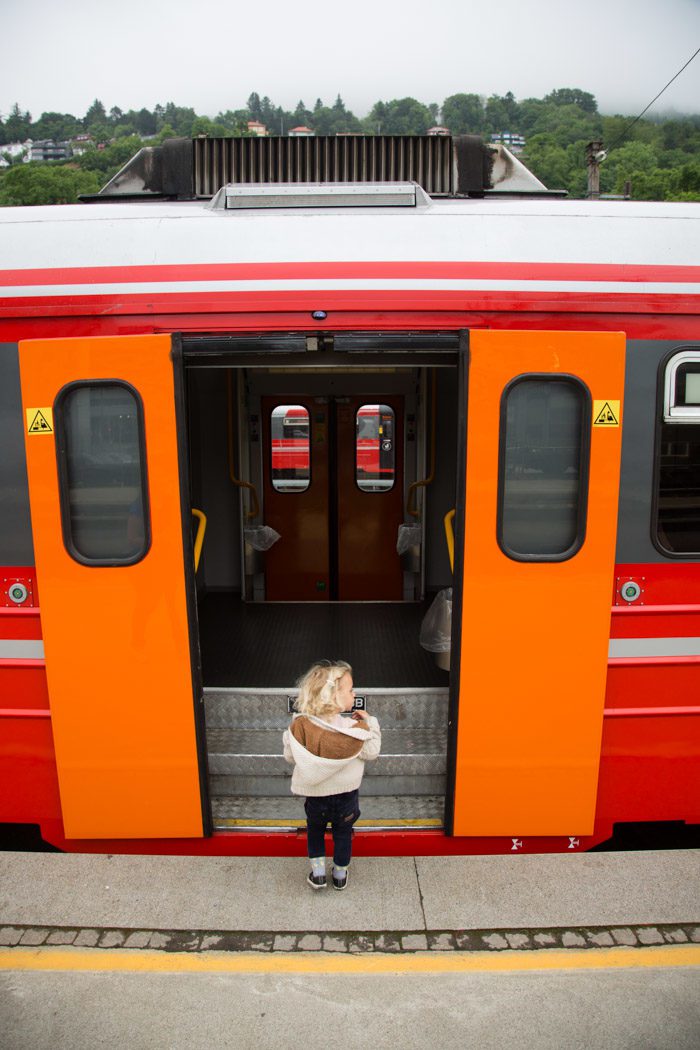
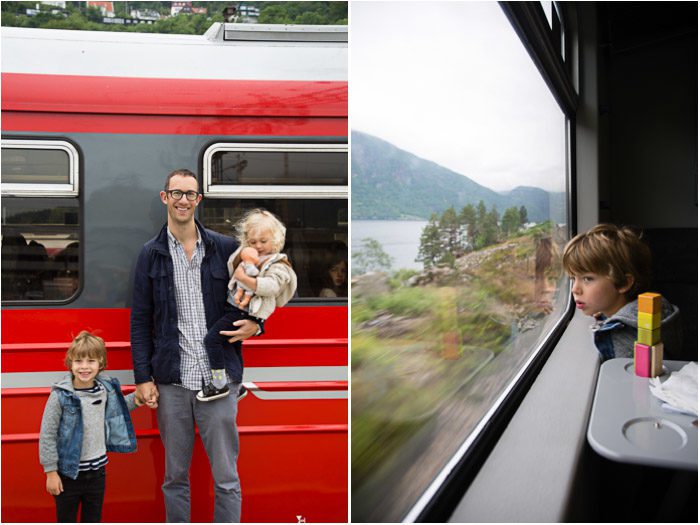
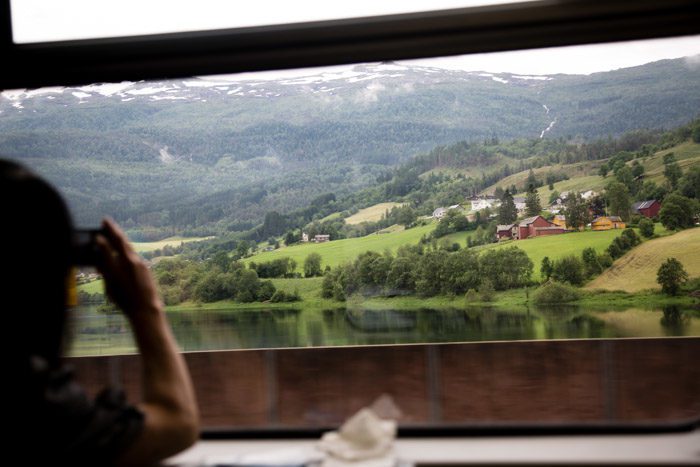
There’s an organized, “official” tour, but it’s basically just offers the convenience of letting someone else make the reservations. If you’re traveling with kids (whose tickets cost less), you can also book each leg yourself, just using the official tour as a guide. We did the latter to save a little money.
The day would go like this, in five legs:
- First, the 8:43am train journey to Voss on the Bergen Railway.
- From Voss, the 10:10am bus ride (down the steep windy roads of Stalheimskleiva in summer) towards Gudvangen.
- In Gudvangen, we’d board an 11:30am fjord cruise on the on the narrow Nærøyfjord as well as Aurlandsfjord, both parts of the giant Sognefjord.
- After that, we’d arrive in the small village of Flåm, for a short break and a ride on the 4:05pm Flåm Railway to Myrdal.
- There, we’d change trains to the Bergen Railway to ride for just under 5 hours through scenic mountain terrain to Oslo, pulling in at 10:30 at night. (You can also take the train back to Bergen to do the whole thing as a round-trip in one day.)
You can see the timetables here for the nutshell route. You have to have a reserved seat on the Myrdal to Oslo (or Oslo to Myrdal) train, so that’s really the limiting factor. When we booked our tickets for that leg, we were able to choose seats in a family car. We also purchased our Flåm Rail passes at that time. In fact, the ticket was purchased on NSB.no as “Flåm to Oslo with one change.” It was about $200 for all of us to do those last two legs, because the kids were free. Otherwise, we stopped in the tourist office in Bergen to buy our first leg train tickets the night before (maybe $50), and paid for our bus and ferry tickets when we arrived (maybe just over $100 total?). It would have been more like $550 to buy the prearranged tickets because only one child was considered free—definitely a savings.

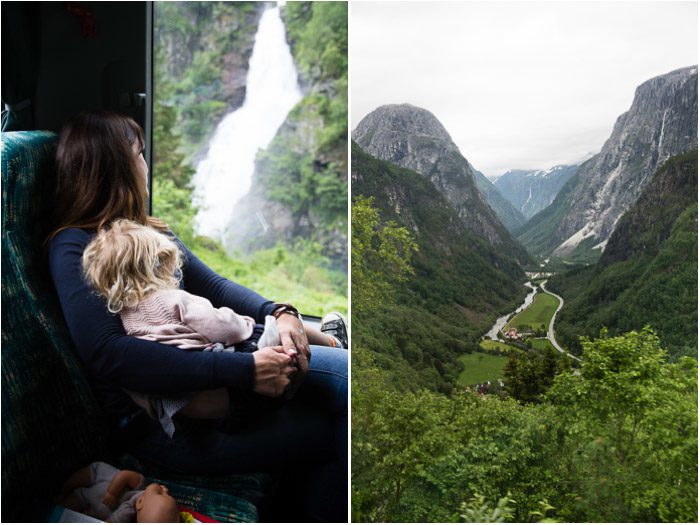
Everything ran extremely smoothly, and it wasn’t too hard getting our bags from one mode of transport to the next. Still, there’s always a little scrambling at the transitions, as everyone angles to get to what he or she thinks are the best seats. The buses filled up quickly and I was glad I got on with the kids while Aron stowed the bags. But otherwise there was always plenty of space to move around if you don’t like where you end up.
And the stunning views begin immediately.
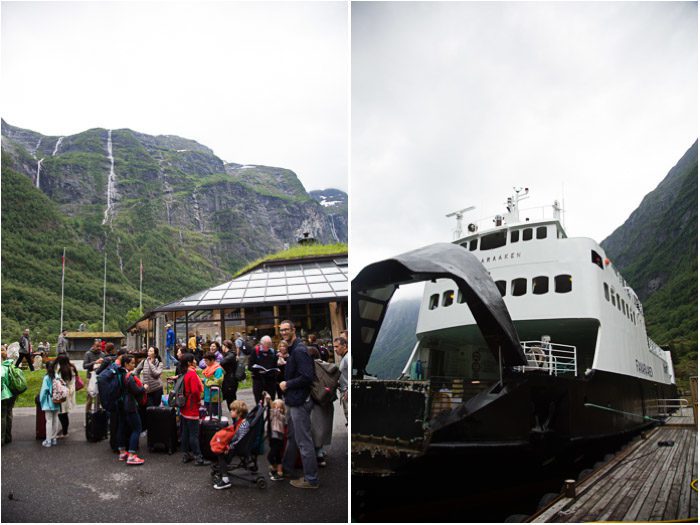
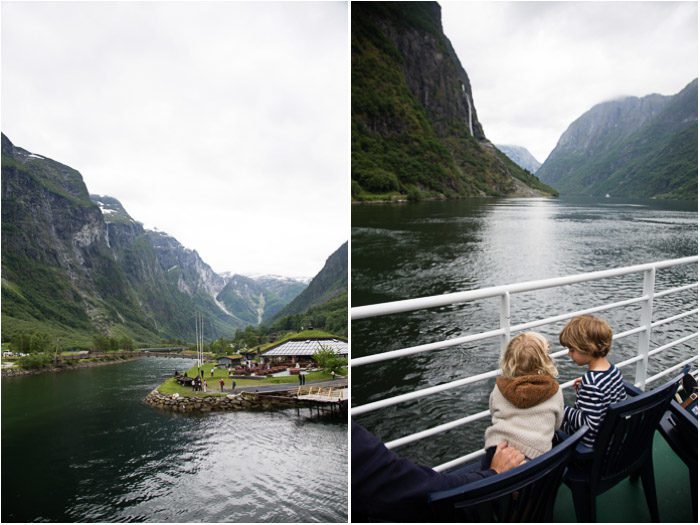
In any normal scenario, the first train ride and the bus trip (minus the part where Skyler got car sick) would be the highlight of the trip. The drama was sufficient. But we were all clearly most excited for what we would see from the Fjord 1 ferry as we cruised the Sognefjord—the longest (127 miles) and deepest (4,265 feet at some points) fjord in the world.
(And we got lucky! No rain! On average, the fjord gets about two feet a year while Bergen gets six. So your chances of a dry day are better, here.)
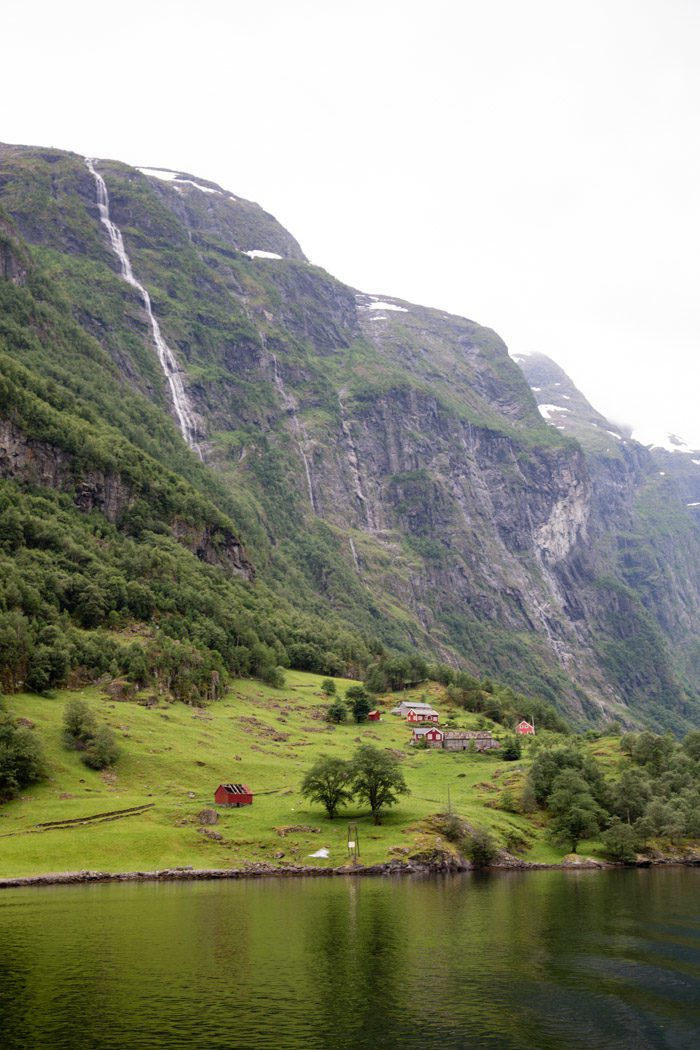
Steep cliffs, covered in waterfalls, plunged into dark water. You could often only grasp their scale when you’d spot a group of goats—just white specks—or a group of kayakers along the shore.

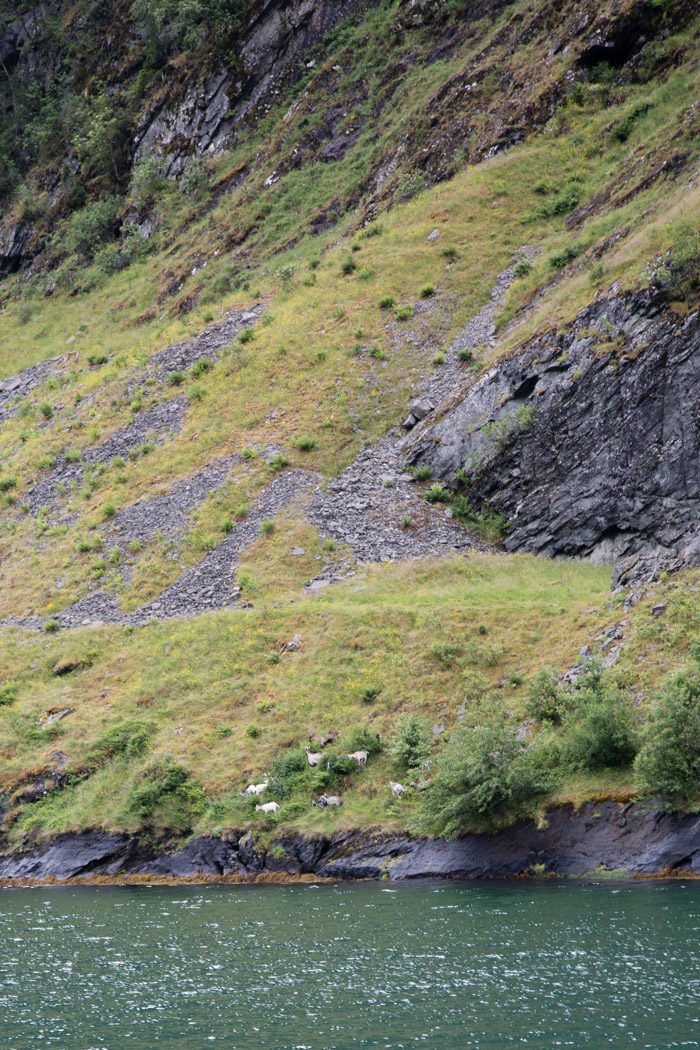
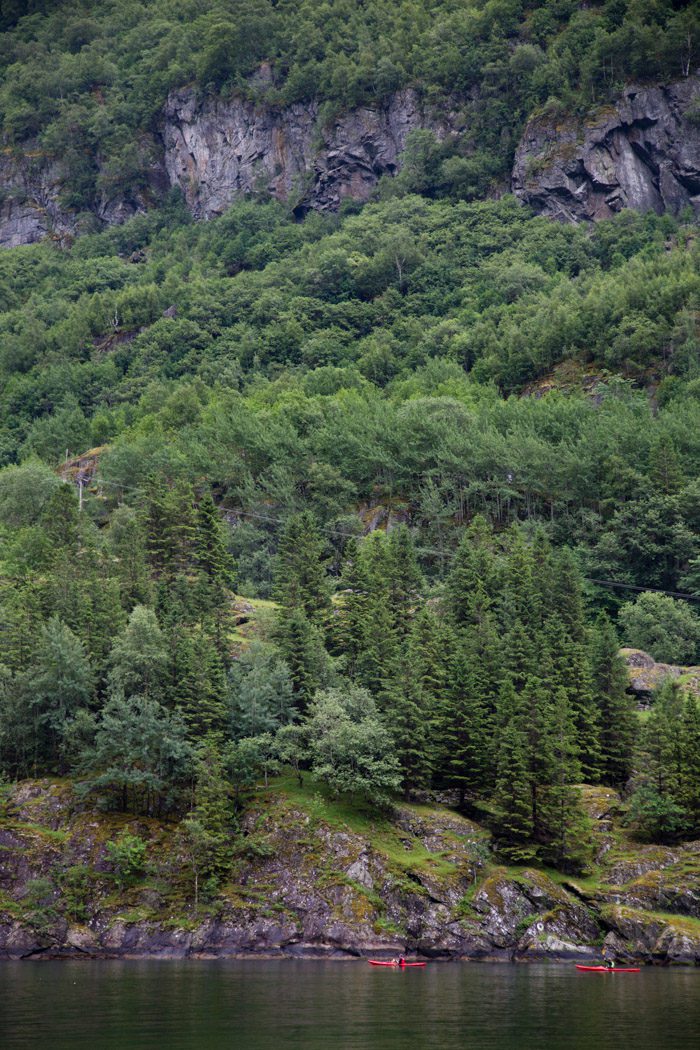

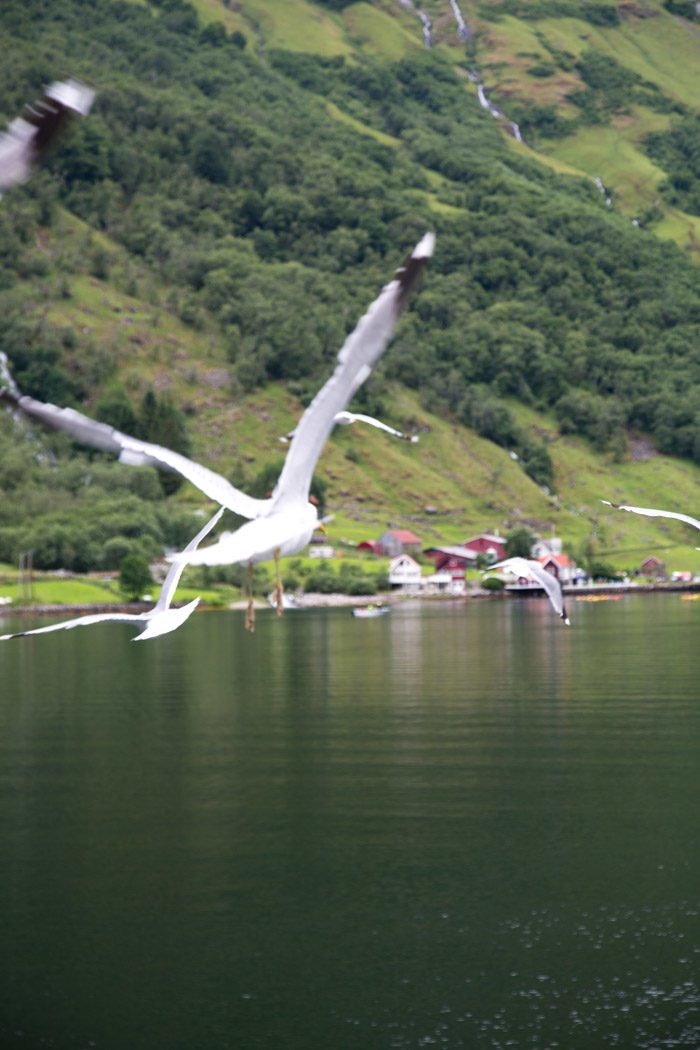
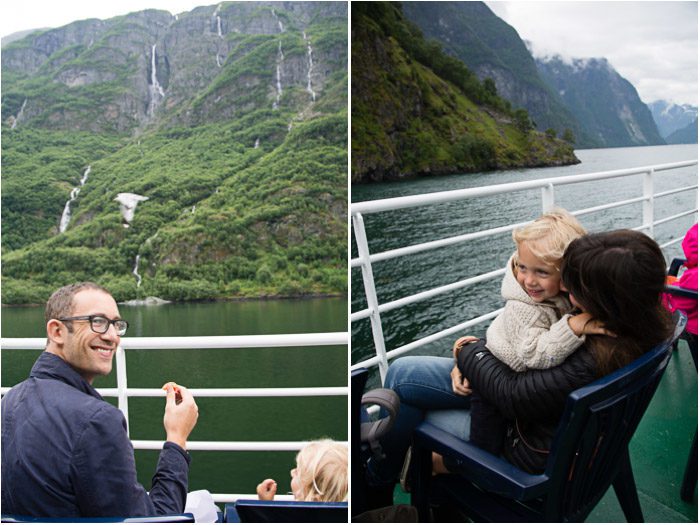
Aron and I thought it reminded us a bit of the renderings we’ve seen of what Yosemite might have looked like just after the ice age. Also glacially formed, that valley was once filled with water and covered in green, too.
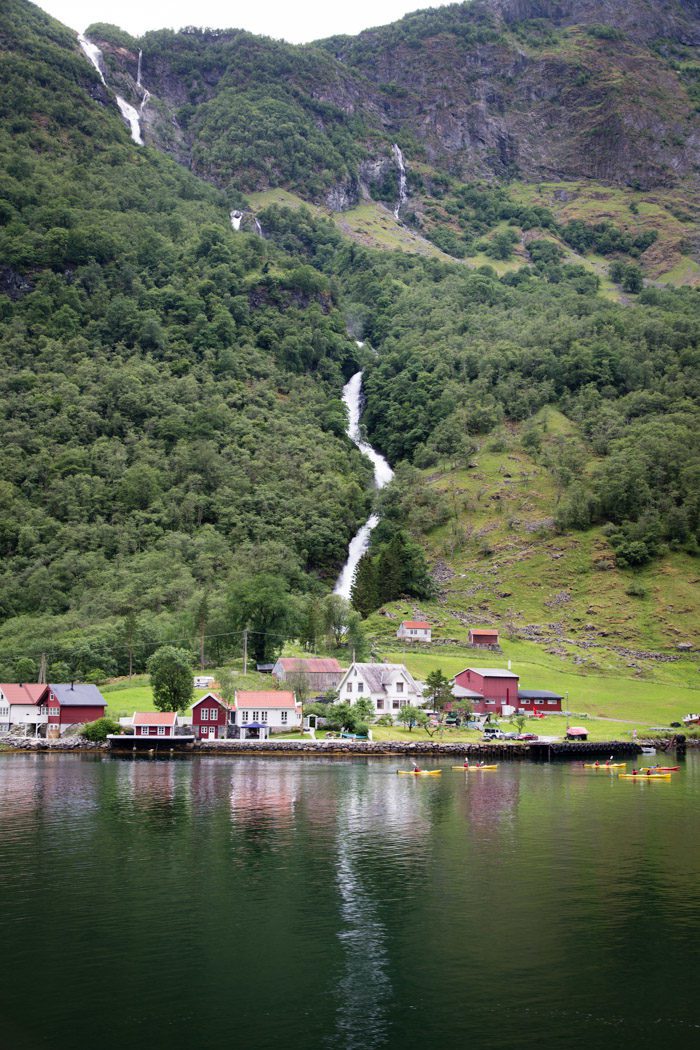
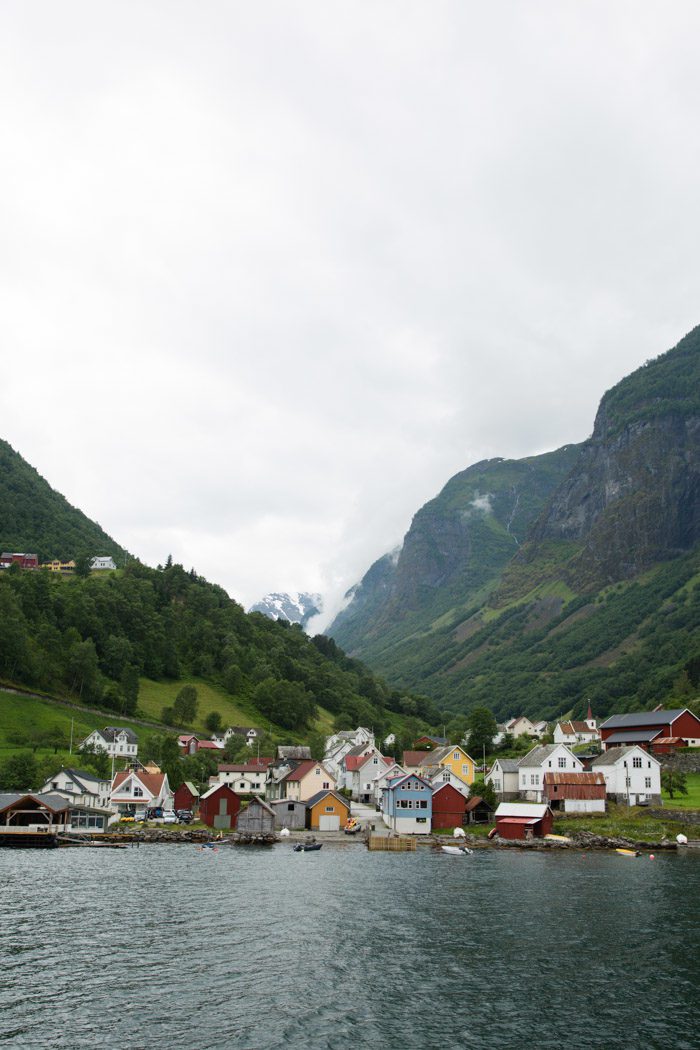

There are a couple of scheduled stops along the route, but in general the captain pulls in upon request—the ferries are the primary means of travel for residents of the fjord.
We tried to imagine getting off and settling in one of the small towns with the kids and thought it would be particularly suited to older ones who could take better advantage of the hiking and kayaking opportunities.
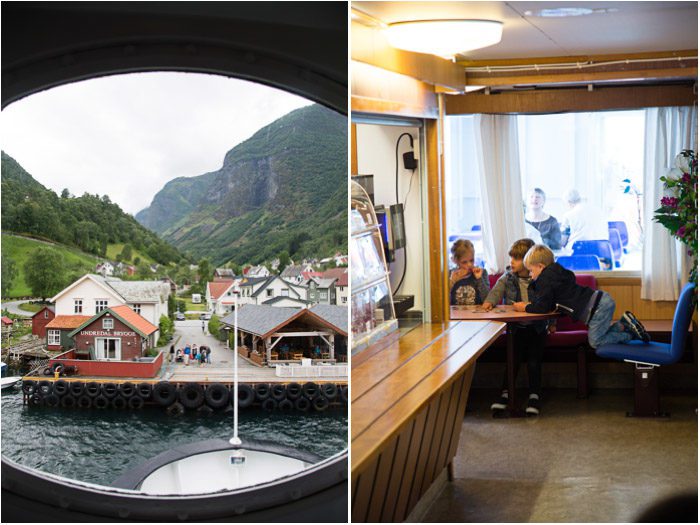
Hudson and Skyler kindly ooh’d and aww’d with us for a while, but soon moved on to other distractions: Hudson made friends with two kids from Sweden who, if he hadn’t been smitten already, gained his loyalty by sharing Toblerone and teaching him Uno Junior.
Skyler stayed more put—at our insistence—with bribes of lox and pretzels. We both confessed that we’d layed awake the night before worrying about the kids’ safety on the boat. Should we put Skyler in some sort of lifevest lest the unthinkable happen and she goes overboard? I shiver just typing that! There was nothing about the boat that ever seemed unsafe or to warrant any specific concern—the railings were consistent, etcetera. But at one point Skyler kicked her shoe off over the edge and it went sailing through the air before plunging into the dark, cold water. “Oh! My shoe down low in babbo!” It’s only when you saw how far the shoe traveled before making contact that you could really get a sense of just how fast the boat was moving. It was alarming to see and, in turn, think through how difficult it would be to ever jump in after someone who went overboard. By the time you could go after them, you’d land in such a different place. And it would be so cold. And…
This is all just to say: every now and then it was a little distracting—seeing our little kiddos sitting with noses up to the railing or watching Hudson run off with his newly-made friends—but I think if one were ever really worried, you could enjoy sitting inside, too.
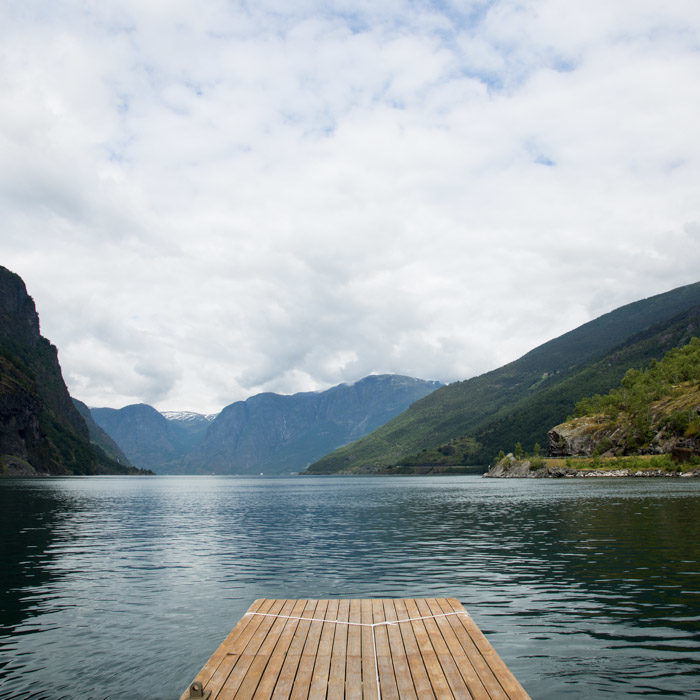
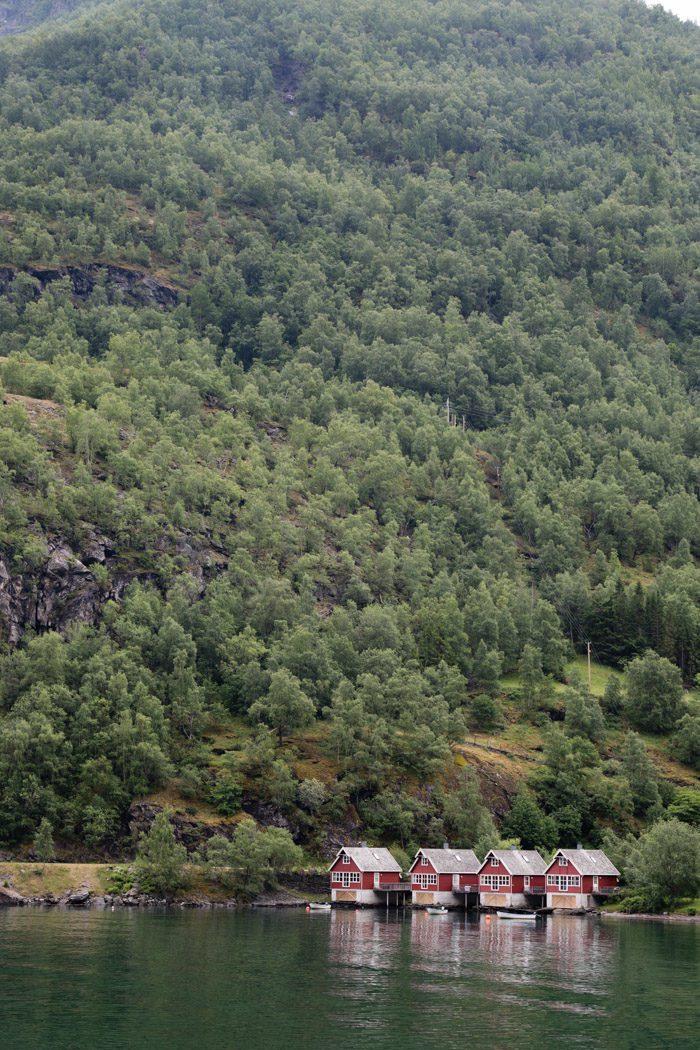
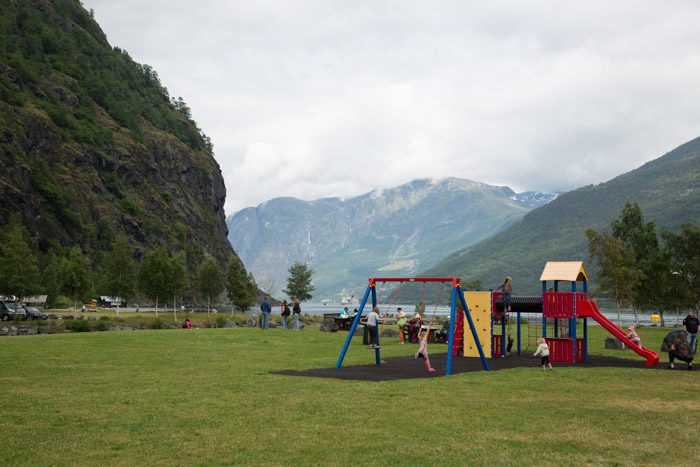
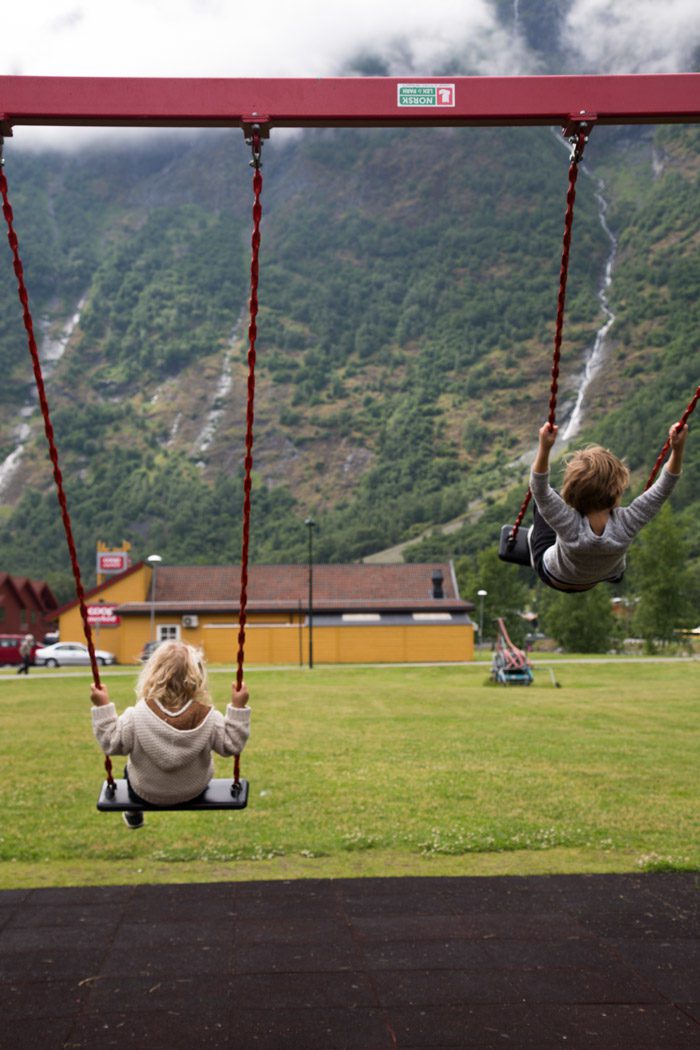
The ferry stops in Flåm—which most guidebooks seem to describe as little more than a transportation hub. That’s probably true, but it also kind of undersells it, because the setting is amazing and jawdropping by any other standards—so one must imagine you’re highly rewarded when you get off the beaten path to warrant that description. According to my buddy Rick (Steves, that is), you should probably at least move a little bit along the road to Aurland if you’re going to overnight in the area just to get away from the port. But it seems like there are a ton of activities—glacier walks, hikes, goat-cheese-tasting tours, fjord safaris (those super-fast boats you can ride and that, apparently, have no age minimum!), and kayak trips that set off from Flåm.
We were tempted by the brewpub that looks like it’s set up in a Viking ship, but didn’t want to subject our kids to any more sitting. So I grabbed some hot dogs (a staple in Norway, afterall) from a cart vendor—love the crunchy onions topping—and we let Hudson take bite breaks in between climbing and swinging. Sidenote: I love this little video Aron captured of this—Skyler with her one shoe trying to follow Hudson, and Hudson climbing all over the place.
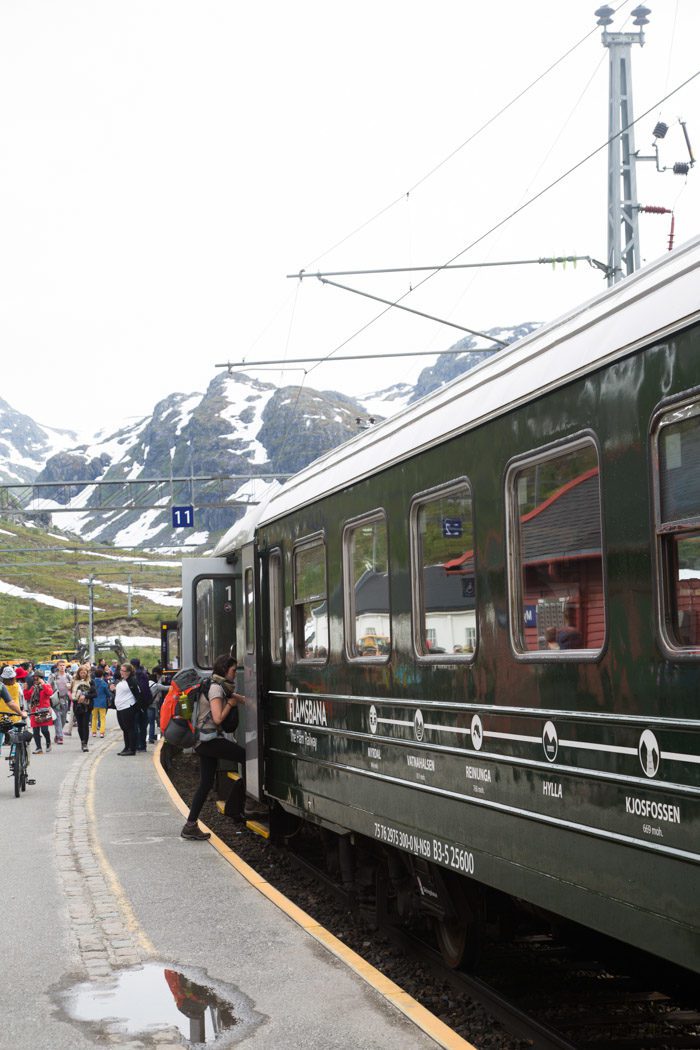
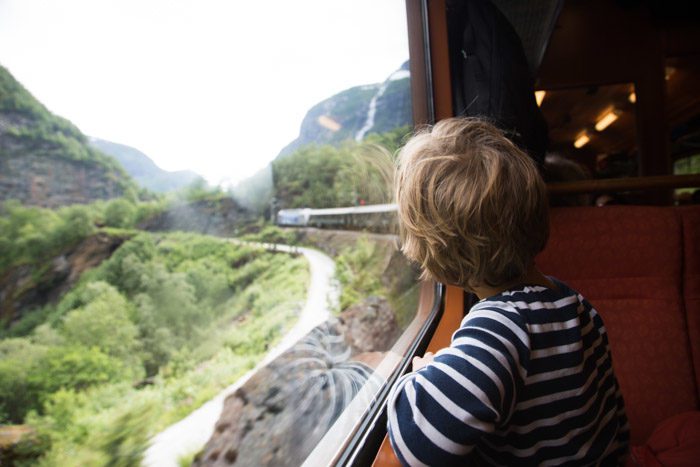
From Flåm, we joined the Flåmsbana railway and headed for Myrdal where we would meet the high speed train headed to Oslo.
One of the steepest standard-gauge railways in the world—almost 80% of the journey has a gradient of over 5%—the views over the Sognefjord are wonderful. Everyone starts lining up early to get the best side of the train, but while I might agree the right is a tad more picturesque going in this direction (up), the difference is small and you can always stand up and look out the other windows. The conductor came around and gave the kids coloring books and pencils (one of many instances where we remarked how family friendly everything here was), and we all waited eagerly for the hour-long ride to begin.
I’d say the excitement lasted about five minutes before everyone was fussy and whining about something, but then we stopped at thundering Kjosfossen waterfall—full of mist this time of year and topped, mysteriously, with a singing woman in red—and it was as if we hit the re-set button. What could possibly be more exciting than that?!
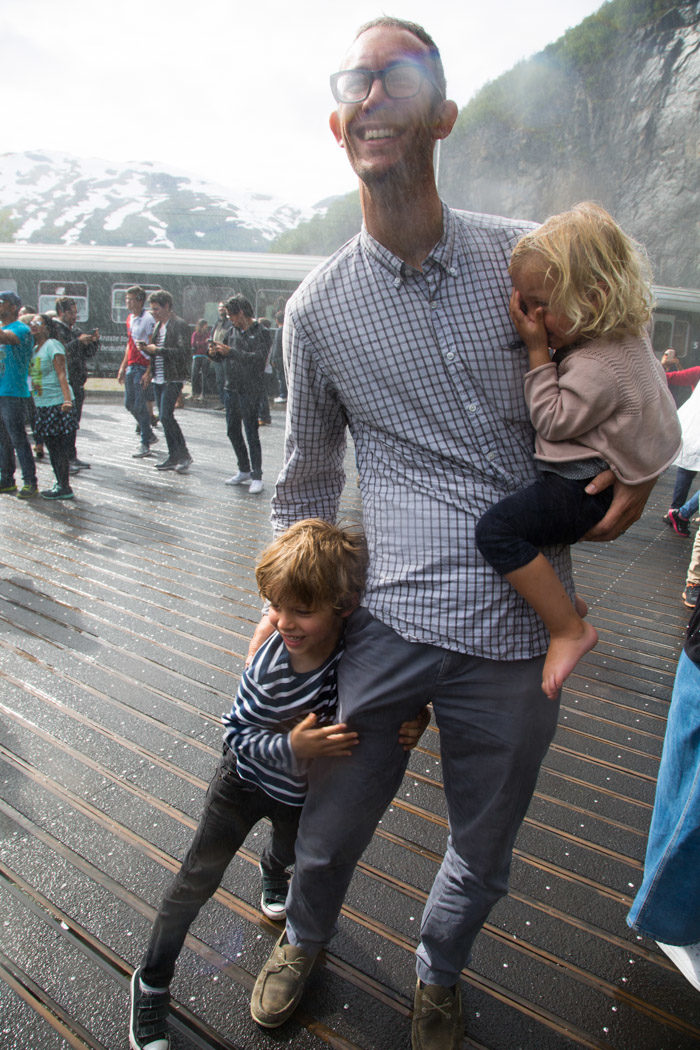
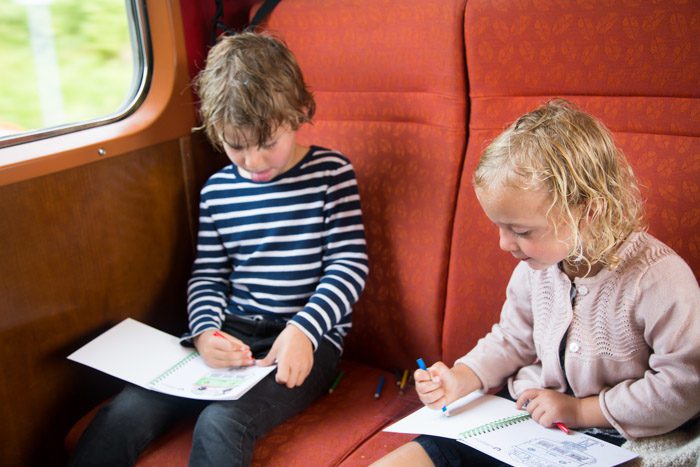
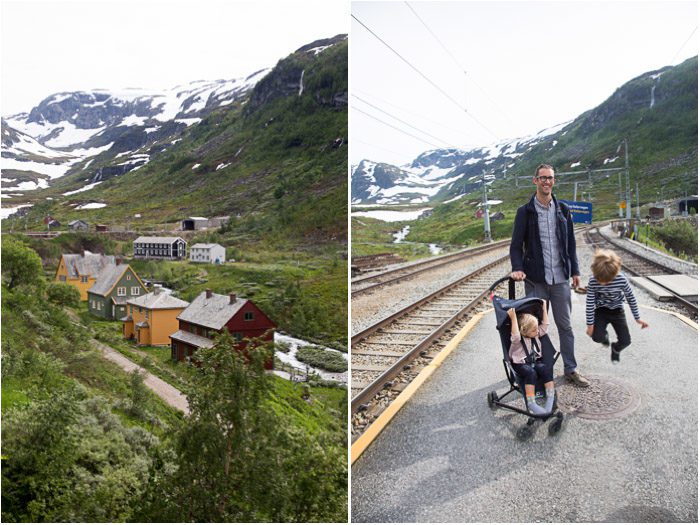
The stop at Myrdal was a brief one—just long enough for some pints for us and ice cream for the kids—and then we settled in for the longest ride of the day.
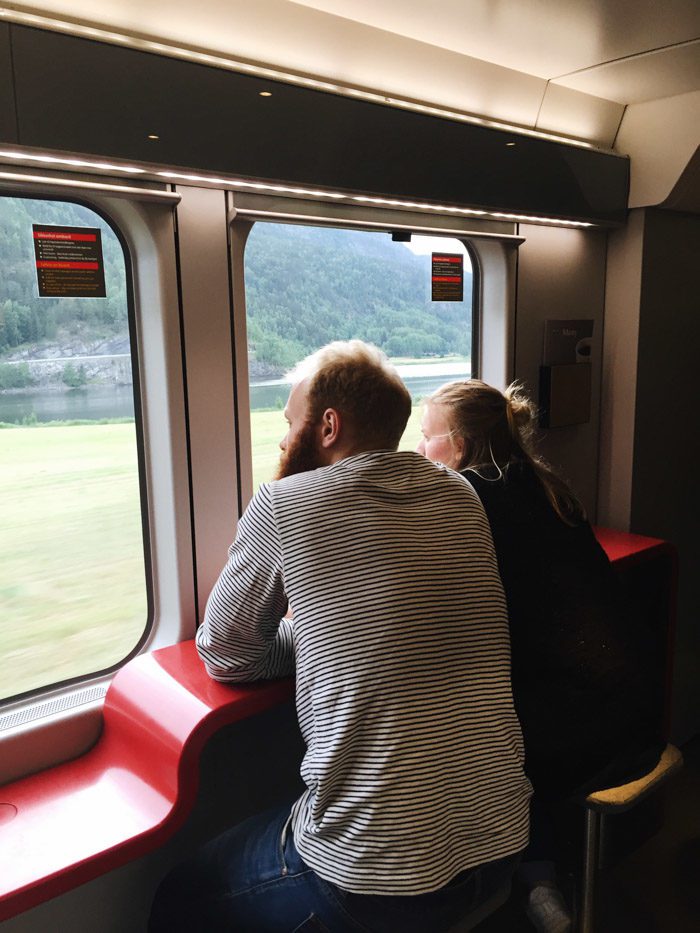

We’d booked tickets on the family car, which had a play space in it (!). Whereas other cars tended to be somewhat quiet, our was pretty raucous, with kids running back and forth between the play space and their tray tables where they were trading soccer cards. There was a little padded loft and climbing tunnel, a few books, and a tv with cartoons and while we never let Skyler play alone in there (the other kids were much bigger), it was nice to be able to stay at our seats while Hudson was having a good time. On the other hand, it was a bit harder than usual to get anyone to go to sleep—which was slightly concerning with a 10:30pm arrival, but we just tried not to worry too much about it.
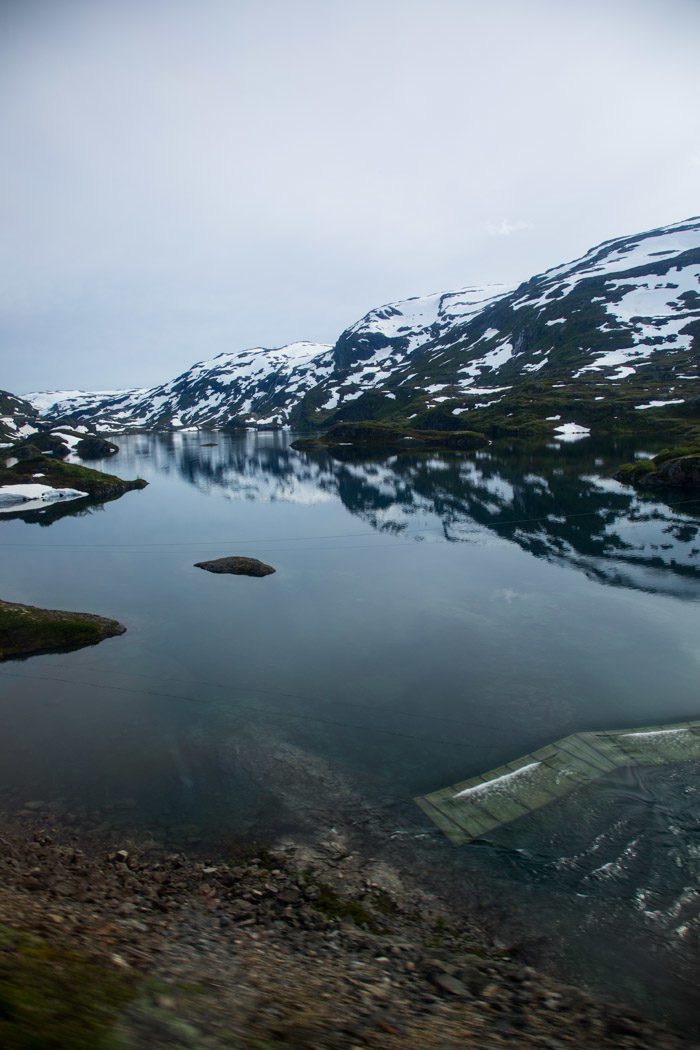
In a way, the scenery on this leg was my favorite yet. I couldn’t tear myself away from the windows: it was otherworldly! Climbing over the tree-less mountains, the Trans-Norway line took years to complete. When it opened in 1908, King Haakon VII described it as “the greatest feat of our generation.” The snow up here lasts year-round and the train must burrow through a series of snow tunnels to keep the line open. I imagine they’re vital, but I’d sadly sigh whenever they closed off the view.
Little red holiday cabins dotted the landscape, though we saw no cars, and we remarked that it looked like something befitting science-fiction. Only later did I learn that—yes!—in fact George Lucas used an area nearby for the ice planet Hoth in Star Wars! It was filmed during a terrible storm, with 18 feet of snow and temperatures as low as –29ºC.
We made one stop, at Haugastøl where travelers got off—apparently it’s the start of hiking routes through the shallow valleys of the high plateau and the beginning of the Rallar Road—but otherwise zipped on to Oslo.
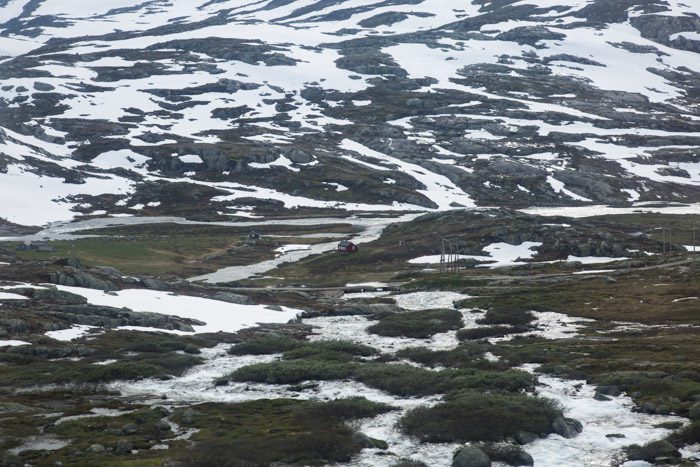

We checked in at the Radisson Blu Scandinavia Hotel and everyone passed out immediately. Lodging is expensive in Oslo, but this one included an incredible breakfast buffet spread that we basically closed down. It was enormous—and so good.
We only planned to spend a few hours in Oslo before hitting the road for our next destination. Had it been sunny, our plan was to visit Vigelandsparken to see Gustav Vigeland’s bronze, granite and cast iron sculptures, but with the rain we switched to the Fram Museum where the Polar Ship Fram, a wooden ship renowned for its strength and its reach (it still holds the records for sailing farthest north and farthest south), takes center stage.
In hindsight, we should have picked up our rental car and driven there directly, but we used an Uber to get to the museum and then to get a ride to the rental pick-up. This was the only time we had any issue with not having our own car-seats, and we had to wait a bit longer. But the location is picturesque—on a small fjord (inlet) with views across the water, with lots of maritime displays.
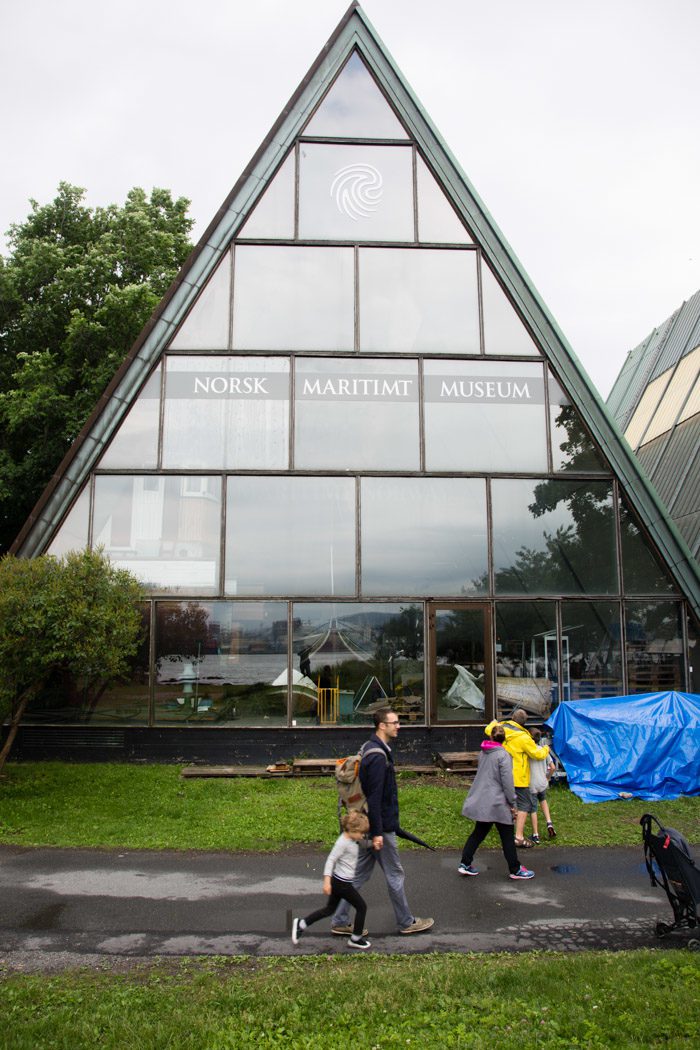
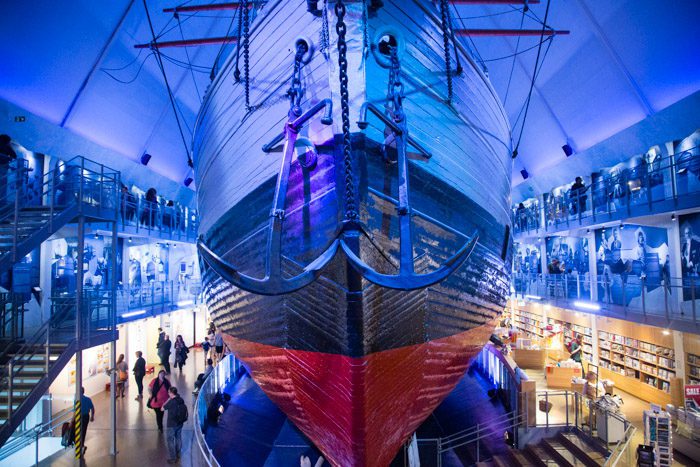

The Polar exhibits were fun for the kids—lots of hands-on activities and a introductory movie with translation headphones. There was also a cold room that simulated freezing temperatures and had some mock-ups of men who had died of frost-bite. Hudson was talking about the macabre scene (with enthusiasm and just a touch of apprehension) for days!
There were also exhibitions on the Arctic and the Northwest Passages and I felt like the museum gave us all a better appreciation of our location on the globe. The entire place is supposed to have a Northern Lights display projected every twenty minutes or so, and while it wasn’t really working it still gave us an opportunity to talk about auroras and how far north we were. Finally, there are lots of interesting stories about Norway’s most famous explorers, who were like astronauts in my mind. What they did was so brave—and crazy! I thought it was a great stop.
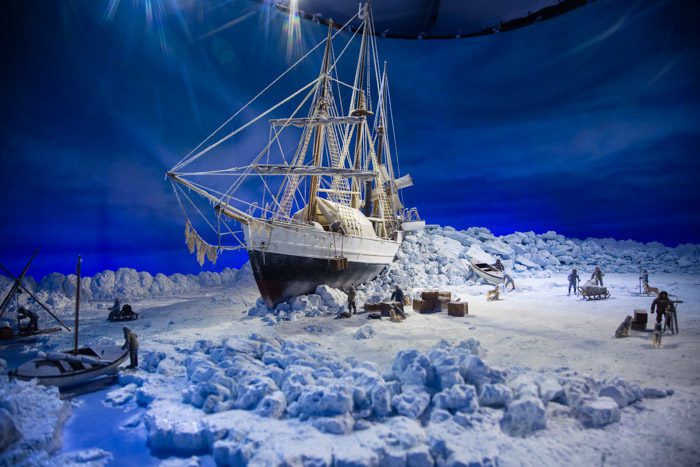
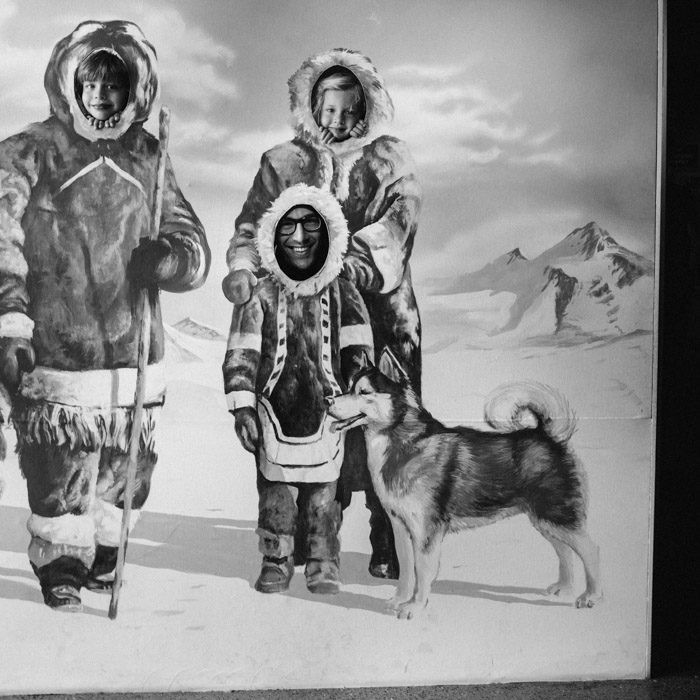
We were sorry to be leaving Norway after such a quick visit. I feel like it’s always a difficult decision: is it better just to get a small taste of a few places or a more in-depth visit to one? We try our best to get the balance right and then, in cases like this where we’ve just been lucky to pass through, we hope we’ll come again. I do think it’s probably especially amazing when everyone is old enough to take full advantage of all the opportunities to get out on the water for adventures!
Next stop: The west coast of Sweden. Followed by Copenhagen.
Previously: Stockholm (and #Scandiscursion)


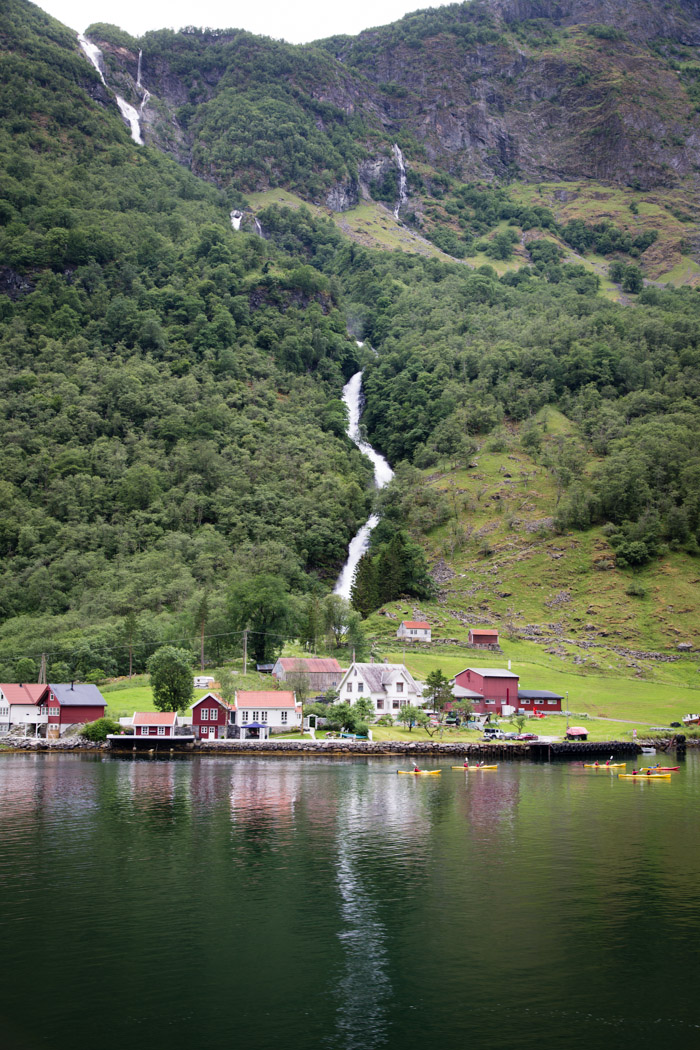
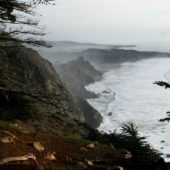
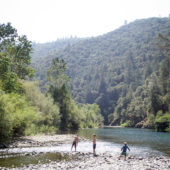
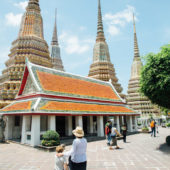











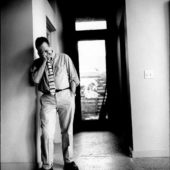
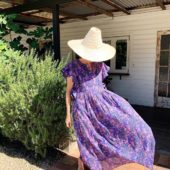
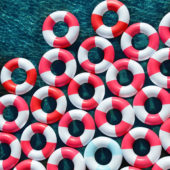


















20 Comments